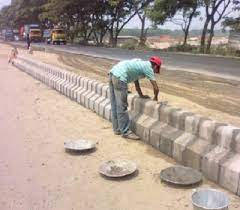Table of Contents
A lengthy, small stone or concrete block, is placed end to end with another to make a Kerb known as Kerb Stone. There are many types of Kerb, divided according to their shape, material, height, and whether the Kerb is prepared with a gutter. Most Kerb is built differently from the pavement, and the gutter is constructed at the joint between the roadway and the curb.

A preparation of Kerb and gutter is also known as “Kerb and channel”. It has a concrete curb and gutter prepared by binding them together in one piece. “Integral curb” is curbing constructed integrally as a part of concrete pavement.
1. Dimensions of Kerb Stone
The standard dimension of Kerb Stone is 450 mm x 300 mm x 150 mm. The dimensions on which Kerb stones are available in the market are:
| Dimensions |
| 450 mm x 300 mm x 150 mm |
| 300 mm X 450 mm X 100 mm |
| 300 mm x 100 mm x 200 mm |
| 300 mm x 50 mm x 200 mm |
| 300 mm x 75 mm x 200 mm |
2. Prices of Kerb Stone
The price of Kerbstones is 60/piece in Indian rupee for a standard size. Where the prices can vary from country to country and size and shape.
| Dimensions | Price (INR) |
| 450 mm x 300 mm x 150 mm | Rs 60/piece |
| 300 mm X 450 mm X 100 mm | Rs 45/piece |
| 300 mm x 100 mm x 200 mm | Rs 75/piece |
| 300 mm x 50 mm x 200 mm | Rs 60/piece |
| 300 mm x 75 mm x 200 mm | Rs 65/piece |
3. Uses of Kerb Stone
The uses of Kerb stone are as follows:
a. Road kerbs
b. Edges of footpaths
c. Pavements
d. Platforms
e. Retaining edges
f. Garden periphery

4. Types of Kerbs Stone Used In Roads
There are four types of kerbs:-
a. Low or Mountable Kerbs.
b. Low-Speed Barrier or Urban Parking Kerbs.
c. High-Speed Barrier Kerbs.
d. Submerged Kerbs.

a. Low or Mountable Kerbs
The low or mountable kerbs are also called class I kerbs. The major use of the Krebs stone is to manage traffic to stay within its lane. To give facilitate the driver to move the area of the shoulder with low difficulty the height of this form of kerb is very low. For the longitudinal drainage system, this type of kerbstone is advantageous and the height of this type of Kerbstone is 70 to 80 mm.

b. Low-Speed Barrier or Urban Parking Kerbs
The low-speed barrier or urban parking kerbs are also called class II kerbs. This type of kerb is used on the footpath to protect against the encroachment of slow speed or parking vehicles. It can also be used in severe emergency vehicles, they can be raised and be parked on the footpath or shoulder.
To neglect the scraping of tires the height of this type of kerb is made of 150 to 200 mm.

c. High-Speed Barrier Kerbs
The high-speed barrier kerbs are also called class III kerb. In the bridges, mountains, or where the path is important there the high-speed barrier kerbs are utilized. The height of this type of kerbs is kept between 230 to 450 mm or high.

d. Submerged Kerbs
The submerged kerb is also called class IV kerb. This type of kerbs is kept on rural roads on the pavement in between edges and shoulders. Submerged kerbs are used to give lateral stability to the granular base course and flexible pavements. In the form of standing bricks or concrete blocks, it is kept.

5. Advantages of Kerbs Stone
The advantages of Kerb stone are as follows:
1. It increases the strength and stiffness and ultimately extends pavements life.
2. It can be painted in any colour.
3. It is very much durable.
4. It is easy to install.
5. It provides an aesthetical beauty to the road.
6. Disadvantages of Kerbs Stone
The disadvantages of kerbs stone are as follows:
1. It is costly to buy.
2. It needs regular maintenance.
3. It can damage the vehicle.
